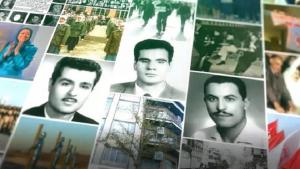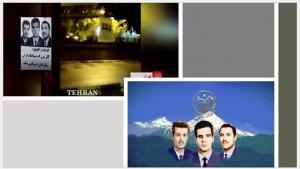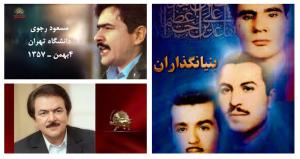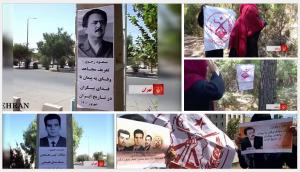(Video) The MEK, harbinger of freedom and democracy in Iran

On September 4, 2020, the network of the People’s Mojahedin Organization of Iran (PMOI/MEK) inside Iran continued to celebrate the 57th anniversary of MEK's foundation for its 57 years of struggle against the monarchist and the mullahs dictatorships.

On Sep 6, 1965, the torch was given to three Iranian youths, Hanifnejad, Mohsen, and Badizadegan, who had been involved in social movements for freedom, they founded (PMOI/MEK) when the Shah regime had suppressed all movements and executed their leaders.

In 1970, the SAVAK, agents arrested all three founders. They were severely tortured, and later on Hanifnejad, Mohsen, and Badizadegan were executed by the shah. After Hanifnejad, the torch was passed on to Massoud Rajavi, the only remaining member of the MEK.
On May 25, 1972, the three founders, along with R. Meshkinfam and M. Asgarizadeh, two members of the MEK’s Central Committee were executed by the Shah regime.
On September 6, 1965, that torch was given to three Iranian youths, Mohammad Hanifnejad, Saeid Mohsen, and Ali Asghar Badizadegan. Hanifnejad, Mohsen, and Badizadegan, who had been involved in previous social movements for freedom, founded the People’s Mojahedin Organization of Iran (PMOI/MEK) at a time when the Shah regime had suppressed all opposition movements and imprisoned or executed their leaders.
Given the environment of suppression that the Shah regime established, MEK remained a secret organization for several years.
During this time, Hanifnejad, Mohsen, and Badizadegan studied the past resistance movements in Iran and other countries and laid the groundwork for what would later become the longest-standing opposition movement in Iran.
The MEK’s founders and early members knew that the only way to achieve freedom was to replace the Shah regime with a popular government whose leaders were elected by the people. Impossible as the goal might have seemed at the time, Hanifnejad and his cofounders did not despair.
And their ideas began to spread, drawing members from Iran’s intellectuals and youth who were distraught by the Shah dictatorship and were committed to serving their people.
In 1970, the SAVAK, the intelligence arm of the Shah regime, arrested most MEK members, including all three founders and its senior members.
After being severely tortured, Hanifnejad, Mohsen, and Badizadegan were sentenced to death, with an option to commute their sentence if they disavowed their ideals.
Knowing that only a great sacrifice would ensure the continuation of the growth of the seed they had planted, Hanifnejad, Mohsen, and Badizadegan rejected Shah’s offers.
On May 25, 1972, the three founders, along with Rasool Meshkinfam and Mahmoud Asgarizadeh, two members of the MEK’s Central Committee were executed by the Shah regime.
After Hanifnejad, the torch was passed on to Massoud Rajavi, the only remaining member of the MEK’s Central Committee, who was saved through the restless efforts of his brother Kazem.
The Shah regime celebrated the deaths of MEK’s founders as a victory, thinking that the movement would wither and die.
But history proved them wrong. As the SAVAK continued to arrest, torture, and execute members of the MEK, the tradition of selfless devotion to freedom set by Hanifnejad and continued under Rajavi would help the MEK to grow in the heart of Iranian youths.
By 1979, when Rajavi and other senior MEK members were freed from prison and the Shah regime was on the verge of collapse, the Mojahedin had become a popular movement with supporters across Iran.
After the 1979 Revolution, while Ruhollah Khomeini was gradually laying the ground to establish his tyrannical rule, the MEK became the largest political organization defending freedom and human rights, with hundreds of offices and millions of supporters across the country.
In 1981, less than three years after the Revolution, Khomeini resorted to the same methods as its predecessor, calling for a total ban on opposition movements and imposing a brutal crackdown on all political movements that didn’t support his regime, including the MEK.
The mullahs’ regime arrested, tortured, and executed tens of thousands of MEK supporters and members, hoping to thus root out their nemesis and main alternative.
At the same time, the regime resorted to terrorist activities and a widespread propaganda campaign against the MEK that continues to this day, trying to discredit them by disseminating lies through state-run media and their lobbies in foreign countries or trying to promote “fake alternatives,” so-called reformist figures, and the remnants of the Shah regime. But again, they were proven wrong.
Today, 57 years after its founding, the MEK has put behind many trials and tribulations. Continuing the tradition of their founders, thousands of MEK members laid down their lives to keep the flame of resistance for freedom alit.
The 1988 massacre of more than 30,000 political prisoners of the heroic operations of the National Liberation Army, and the 14-year resistance of MEK members in Camps Ashraf and Liberty are just some of the highlights of the history of the main Iranian opposition movement after the fall of the Shah regime.
Today, a new generation of Resistance Units are continuing the path of thousands of MEK martyrs that came before them. Their activities can be seen and heard in every city and town, and they stand against the regime’s efforts to maintain its rule through oppression and violence.
The continued growth of the Resistance Units, who are carrying out their activities at great risk to their lives, is proof of the righteousness of the cause and vision of MEK’s founders.
As Moussa Khiabani, a senior member of the MEK killed by the regime in 1982, once said, “You might kill us, you might imprison us. But the Mojahedin can’t be destroyed.
This ideal can’t be destroyed because it is just. It will find its place in society and history. If this flag falls from our hands today, other hands will certainly grasp and lift it again.”
Shahin Gobadi
NCRI
+33 6 61 65 32 31
email us here
The Shah regime celebrated the deaths of MEK’s founders as a victory, thinking that the movement would wither and die and so did the mullahs thought the same.
Legal Disclaimer:
EIN Presswire provides this news content "as is" without warranty of any kind. We do not accept any responsibility or liability for the accuracy, content, images, videos, licenses, completeness, legality, or reliability of the information contained in this article. If you have any complaints or copyright issues related to this article, kindly contact the author above.


